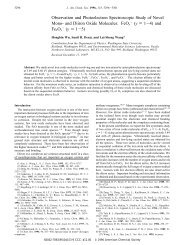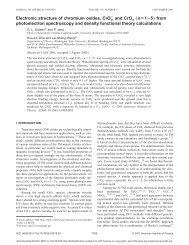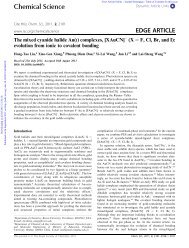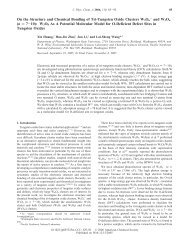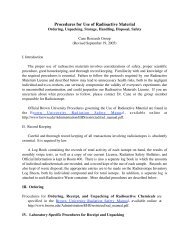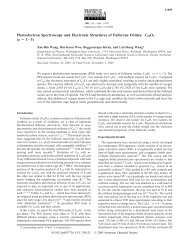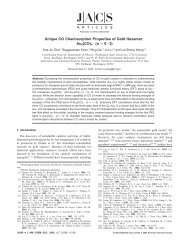A study of the structure and bonding of small aluminum oxide ...
A study of the structure and bonding of small aluminum oxide ...
A study of the structure and bonding of small aluminum oxide ...
You also want an ePaper? Increase the reach of your titles
YUMPU automatically turns print PDFs into web optimized ePapers that Google loves.
Desai et al.: Aluminum <strong>oxide</strong> clusters<br />
1311<br />
TABLE I. Selected, scaled symmetric vibrational frequencies <strong>of</strong> Al 2 O y clusters<br />
at <strong>the</strong> HF/6-31G(d) <strong>and</strong> MP2/6-31G(d) levels.<br />
Species Symmetry HF a MP2 b Expt<br />
Al 2 O 3 C 2v Rhombus 888 cm 1 804 cm 1 850 80 cm 1<br />
D h 904 cm 1 868 cm 1<br />
C 2v Planar 1097 cm 1 1073 cm 1<br />
Al 2 O 4 D 2h 932 cm 1 --------- 930 60 cm 1<br />
C 2v 1 968 cm 1 914 cm 1<br />
C 2v 2 1019 cm 1 964 cm 1<br />
Al 2 O 5 C 2v 1023 cm 1 964 cm 1 900 60 cm 1<br />
a HF frequencies have been scaled by 0.89 Ref. 69.<br />
b MP2 frequencies have been scaled by 0.94 Ref. 69.<br />
produce it at various source conditions. It is expected that<br />
Al 2 O <strong>and</strong> Al 2 O might be too reactive to be present with any<br />
appreciable concentrations under our source conditions.<br />
III. COMPUTATIONAL METHODS<br />
Using <strong>the</strong> Gaussian 94 systems <strong>of</strong> programs, 67 preliminary<br />
calculations on low-lying neutral singlets <strong>of</strong> Al 2 O 3 ,<br />
Al 2 O 4 , <strong>and</strong> Al 2 O 5 have been performed. Geometric <strong>structure</strong>s,<br />
energies, <strong>and</strong> harmonic frequencies have been obtained<br />
at <strong>the</strong> Hartree–Fock HF <strong>and</strong> second-order perturbation<br />
MP2 levels <strong>of</strong> <strong>the</strong>ory, using <strong>the</strong> 6-31G(d) basis set. The<br />
MP2 calculations employed <strong>the</strong> frozen core convention. The<br />
results are presented in Table I, while a more detailed analysis<br />
will be published elsewhere. 68 HF frequencies have been<br />
scaled by 0.89 <strong>and</strong> MP2 frequencies by 0.94. 69<br />
IV. RESULTS<br />
Figure 1 shows <strong>the</strong> PES spectra <strong>of</strong> AlO <strong>and</strong> AlO 2 at a<br />
photon energy <strong>of</strong> 6.42 eV. For AlO a sharp peak is observed<br />
at 2.60 eV X 2 <strong>and</strong> a broad feature A 2 at<br />
higher binding energy is also observed. The spectrum also<br />
shows a sharp peak B 2 at 5.19 eV. Significant noise is<br />
present at <strong>the</strong> high BE side <strong>and</strong> <strong>the</strong> feature near 6 eV is really<br />
due to imperfect background subtraction. The spectrum <strong>of</strong><br />
AlO 2 shows a sharp peak (X 2 g) at 4.23 eV <strong>and</strong> two additional<br />
features at 4.88 eV (A 2 u ) <strong>and</strong> 5.08 eV (B 2 g ).<br />
The feature at 4.88 eV also appears to contain vibrational<br />
<strong>structure</strong>.<br />
Figure 2 displays <strong>the</strong> spectra <strong>of</strong> Al 2 O 2 taken at photon<br />
energies <strong>of</strong> 2.33 eV <strong>and</strong> 3.49 eV. In Fig. 2a, a sharp peak<br />
(X 1 A g ) is observed followed by peaks at higher binding<br />
energies, which are members <strong>of</strong> a vibrational progression.<br />
The spectrum at 3.49 eV shows a second b<strong>and</strong> (A 3 B 3u )at<br />
higher binding energy, which is nearly identical to <strong>the</strong> X 1 A g<br />
b<strong>and</strong>, with a slightly higher relative intensity.<br />
Figure 3 shows <strong>the</strong> spectra <strong>of</strong> Al 2 O y y2–5 clusters at<br />
both 4.66 <strong>and</strong> 6.42 eV photon energies. The noise problem at<br />
high photon energies, mentioned above, can be clearly seen<br />
for <strong>the</strong> 6.42 eV spectra, on <strong>the</strong> high BE side. The spectrum<br />
for <strong>the</strong> Al 2 O 2 molecule at <strong>the</strong> higher photon energies reproduces<br />
<strong>the</strong> two features X 1 A g <strong>and</strong> A 3 B 3u observed at <strong>the</strong><br />
lower photon energies. Additionally, a third broad feature<br />
(B 3 B 3g ) at high BE 5.1 eV is also revealed at <strong>the</strong> 6.42 eV<br />
FIG. 1. a Photoelectron spectrum <strong>of</strong> AlO at 6.42 eV 193 nm photon<br />
energy <strong>and</strong> b Photoelectron spectrum <strong>of</strong> AlO 2 at 6.42 eV.<br />
photon energy. For Al 2 O 3 , <strong>the</strong> 4.66 eV spectrum shows a<br />
weak, broad b<strong>and</strong> (X) at lower BE <strong>and</strong> a sharp peak (A) ata<br />
BE <strong>of</strong> 4.32 eV. At 6.42 eV photon energy, <strong>the</strong> intensity <strong>of</strong><br />
<strong>the</strong> low BE broad feature is considerably enhanced <strong>and</strong> <strong>the</strong><br />
vibrational progression is much better defined. This feature<br />
represents <strong>the</strong> ground electronic state <strong>of</strong> <strong>the</strong> neutral Al 2 O 3<br />
<strong>and</strong> is characterized by a strong wavelength dependent photodetachment<br />
cross section. A third feature (B) may also be<br />
present at higher BE, but <strong>the</strong> severe noise problem makes its<br />
identification ra<strong>the</strong>r difficult. The spectra for Al 2 O <br />
4 <strong>and</strong><br />
Al 2 O 5 also exhibit a vibrationally resolved ground state (X)<br />
<strong>and</strong> an excited state at high BE 5.1 eV. The similarity<br />
among <strong>the</strong> spectra <strong>of</strong> Al 2 O 3 ,Al 2 O 4 , <strong>and</strong> Al 2 O 5 suggests<br />
that <strong>the</strong>y may have very similar electronic <strong>and</strong> geometric<br />
<strong>structure</strong>s, most likely based on <strong>the</strong> rhombus configuration,<br />
as will be discussed in <strong>the</strong> next section.<br />
The obtained energies <strong>and</strong> spectroscopic constants are<br />
summarized in Table II.<br />
V. DISCUSSION<br />
The <strong>aluminum</strong> atom has a 3s 2 3p 1 valence configuration<br />
while <strong>the</strong> oxygen atom has a valence configuration <strong>of</strong><br />
2s 2 2p 4 . The three valence electrons mean that <strong>aluminum</strong> has<br />
an optimum oxidation state <strong>of</strong> 3, which is well known <strong>and</strong><br />
found in all Al compounds including Al 2 O 3 . When forming<br />
bonds with <strong>the</strong> oxygen atom, <strong>the</strong> <strong>aluminum</strong> atom tends to<br />
donate its valence electrons to <strong>the</strong> oxygen atom to form a <br />
J. Chem. Phys., Vol. 106, No. 4, 22 January 1997<br />
Downloaded¬26¬Jun¬2007¬to¬130.20.226.164.¬Redistribution¬subject¬to¬AIP¬license¬or¬copyright,¬see¬http://jcp.aip.org/jcp/copyright.jsp



